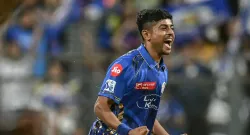
Picture Credit: Twitter
A heady cocktail of colourful costumes, ear-splitting noise and immense passion can mean only one thing at an ICC Cricket World Cup – India against Pakist an.
Since their first meeting in 1952, the two teams have shared some of the most dramatic matches and jaw-dropping moments in cricket history.
Ahead of their latest meeting on 14 October, we examine just how big the rivalry has become and the current state of play ahead of their duel in Ahmedabad.
White-ball cricket’s fiercest rivalry?
A look back at the numbers from their 2019 showdown serves as a reminder of the scale of the occasion.
Over 700,000 ticket requests, 600 media requests, a reported one billion TV viewers – and that was ahead of a sodden Sunday affair in Manchester, never mind a sultry Saturday at the world’s largest arena, the Narendra Modi Stadium.
The Ashes may have history on its side, and there is no lack of bite when England and Australia collide, but their meetings in the shorter format might not quite have the same edge as when India take on Pakistan.
Their meetings in cricket’s global event are as close to a rock concert as the sport will come.
A history like no other
From an opening meeting in the format in 1978 which went down to the final ball – India winning by four runs – this rivalry has been electric.
Pakistan have enjoyed the better of it overall, winning 73 times to their neighbours’ 56, but on the World Cup stage, the roles have been reversed.
The teams first met in 1992 in the World Cup, with India winning by 43 runs in Sydney, and they have a perfect record ever since, winning all seven meetings.
Of course, for Pakistan, that 1992 tournament still brings with it happy memories, as Imran Khan led them to their only World Cup victory to date.
In head-to-heads though, it is India who have claimed the bragging rights, with perhaps the most entertaining meeting coming in 2003 when Saeed Anwar’s stunning century was cancelled out by a brilliant 98 from Sachin Tendulkar as India won by six wickets on their way to a place in the final.
Tendulkar was at it again in an iconic knock in the 2011 semi-final as India won the title on home soil, while Virat Kohli’s courageous century in 2015 was a reminder that the world’s best players always seem to hit top form when the neighbours are in town.
What to expect this time...
After ending a five-year trophy drought with a resounding Asia Cup success, expectations are sky-high for host nation India.
Preparations until now could not have gone much better, with KL Rahul and Jasprit Bumrah back to their best, Shubman Gill in irresistible form and Kuldeep Yadav showing why he is indispensable.
Left-arm wrist-spinner Kuldeep finished the tournament with nine wickets at 11.44 and his effectiveness in the middle overs could prove crucial in stifling India's nearest and dearest.
There were mitigating circumstances for Pakistan's Asia Cup struggles, with injuries to Naseem Shah and Haris Rauf debilitating their pace attack.
Naseem’s potentially tournament-ending shoulder injury is a particular cause for concern, with the 20-year-old boasting a fine record against the Men in Blue.
They will be up against it, crossing the border for ODI action for the first time in a decade, but will be determined to bounce back quickly.
What is for sure, is that every run will be an event, every wicket cheered like a win and at the end of it all, one team will take a giant step towards fulfilling the hopes and dreams of a nation.




